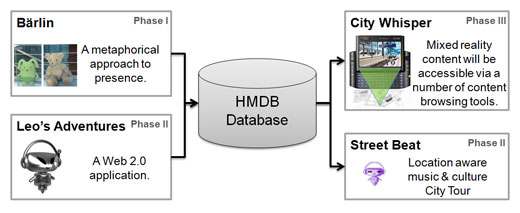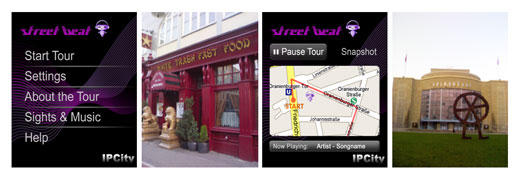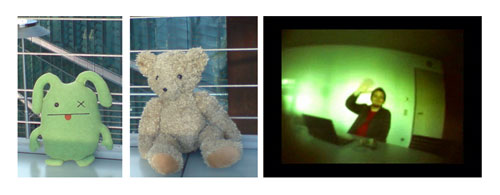City Tales I
City Tales I concentrates on HCI (Human-computer interaction) aspects of presence. We design user interfaces that are easy to use and easy to understand, that meet the need of a non technical user and that support such users in producing mixed reality content. For City Tales I the way in which the user is enabled to create a mixed reality story is the core research interest and will drive all other related research aims and functionalities.

Leo’s Adventures
“Leo’s Adventures” is a web based mixed reality (MR) user generated content tool developed in flash. Visitors will be invited to browse the content created by others and to upload their own videos and create an MR video via simple post production animation tools. The story is about Leo an alien from the planet of “CISUM 52” landed on earth to research human emotions. Leo’s first stop on earth is Berlin where he is trying to find out about subculture and music. Leo needs the help of users to find the coolest spots in Berlin by uploading a short video and placing Leo inside their stories. The content will be stored geographically both on the web interface and in the real world to allow for a MR exhibition in the real world at a later stage of the project. For Leo’s adventures we are using an iterative approach. Starting of with base functionality and a limited number of animations we will create an explorative evaluation using a participatory heurist evaluation. After another user interface design iteration to improve the usability of the application we will evaluate Leo’s adventures based on the Presence concept map developed in WP3 and open the application to a wider public.

StreetBeat
StreetBeat (Pervasive Service Prototype)
Street Beat is a location aware mobile, music based City tour. While exploring Berlin the visitor listens to urban music and stories about sub-culture of the Streets of Berlin. The intention is to immerse the “story-browsers” into a sub-cultural story told by a professional music editor about hip areas in Berlin. The user is lead through the city based on the musical relevance of certain urban locations, with the music and cultural narrative being altered depending on the location. Our main aim is to explore how immersed users feel in location based stories and how present they feel in the audio content provided at the predefined locations. Figures below show the initial user interface design and screenshots of the application.

Place, Presence and Street Beat
One of the key aims of Street Beat is to make people feel present in the cultural experience of the locations visited during the tour. However, it is important to note that they are unable to physically enter many of them. Indeed their only connection to the inside of many of the locations is the content presented on their mobile phone.
There are also varying types of presence such as: physical, social and co-presence [1]. Physical presence is when someone feels they are physically somewhere. Social presence is when they feel they are with others either locally or remotely and finally co-presence is when someone feels they are co-located somewhere else with other people and is related to physical and social presence. The sense of presence in Street Beat straddles the middle ground, in that we are asking people to feel present in a location which they know little about and with people who are not represented in anyway. In many ways this is quite similar to the sense of being immersed in a book, where words and pictures are the only gateway into a new and perhaps fantastic world. In the context of the work here we will call this “cultural presence” as we are seeking to make people feel as if they are part of a specific cultural experience both at individual locations and as they walk around the city; where this sense of culture has no specific time, people or even a specified location either within a building or across the entire city. However it should be noted that this interpretation of presence is more for the purposes of exploring the nature of presence in this context, rather than to define yet another form of presence.
In many ways the feeling of being culturally present within an experience shares many aspects of sense of place. According to Relph, place is a combination of the physical properties, meanings and activities [2]. Sense of place can evolve through second hand information, for example you can read a travel guide and decide which areas sound interesting or boring. Photographs can also engender a sense of place. However anecdotal evidence suggests that a truly strong sense of place can only arise through first hand experience. In the context of Street Beat, the nearest to first hand experience is often standing outside the building. Therefore there is a need to explore which content can create this sense of place and in turn make people feel present within the various locations.
Bärlin

Bärlin was an early prototype to evaluation a metaphorical approach to presence by applying a tangible user interface that allows content creation for everyone. The approach was to enable a fast majority of users to produce user generate content that portrays an element of social presence. The stories created using Bärlin are aimed at making the observer of the video’s feel part of the presence of a virtual character. The viewer sees the story teller and his/her surrounding from the view of the toy and feels socially present in the story told by the user. During this early prototype development and the initial test evaluations we concluded that although “Bärlin” is an interesting tool to evaluation social presence in general it does not provide enough evidence for a wider mixed reality user generated mixed reality application for this reason we stopped development for Bärlin and decided to use it for some simple evaluation purposes. However, Bärlin provided some interesting and valuable input for a more active form of story telling and user generated content we may pick up on a later prototype.
References
[1] IJsselsteijn, W.A. & Riva, G. (2003). Being There: The experience of presence in mediated environments. In: Riva, G., Davide, F., & IJsselsteijn, W.A., (eds.), Being There – Concepts, Effects and Measurements of User Presence in Synthetic Environments, Amsterdam: IOS Press. pp. 3-16.
[2] Relph, E. Place and Placelessness. (1976). Pion Books, London.



